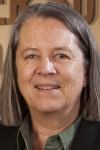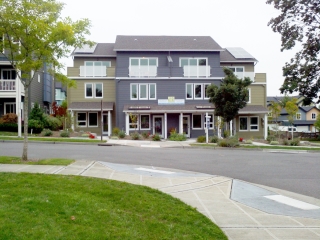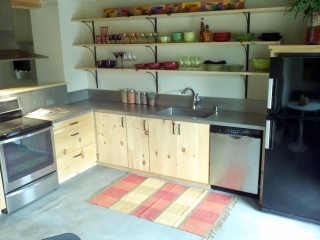|
Subscribe / Renew |
|
|
Contact Us |
|
| ► Subscribe to our Free Weekly Newsletter | |
| home | Welcome, sign in or click here to subscribe. | login |
Construction
| |

February 27, 2014
'Queen of Green' survives the recession; keeps building super efficient homes
Journal Staff Reporter
Seattle contractor Martha Rose, known as the “Queen of Green,” has promoted sustainable building practices since the late 1970s.
In the recession Rose lost “a lifetime worth of savings” on Fish Singer Place, a super green four-house project in Shoreline.
“I got slaughtered,” she said. “I almost went under. It was the most difficult five years that I ever experienced in my business, and half of my peers went out of business. It was so bad that I had to take up roller skating because I needed something in my life that was scarier than my business.”
Nowadays Rose's firm, Martha Rose Construction, is back making money with City Cabins, a brand of 5-Star Built Green certified homes she started in 2011.
They are super energy efficient, have water conservation features and are constructed with materials produced in the region. Also stormwater on the building site is filtered before it enters Puget Sound.
Rose sold four City Cabins townhouses in Columbia City in 2013 and two in Queen Anne in early 2012.
The just over 2,000-square-foot, three-bedroom-plus-loft, 2.5-bath homes in Columbia City went for about $415,000, and the comparable townhomes in Queen Anne sold for about $600,000.
Now Rose plans two townhouses in her City Cabins at the Indian Wall development at North 92nd Street and Ashworth Avenue North, which is named for murals by artist Andrew Morrison across the street.
An advocate
Rose is known as much for her advocacy as her developments.
Recently, the National Association of Home Builders named her Builder Advocate of the Year.

She has been in the leadership of the Master Builders Association of King and Snohomish Counties since late 2011, and is now its president.
Her unpaid duties include leading committee meetings, going to legislative gatherings, participating in philanthropic projects, attending events and helping to plan MBA functions.
That's not all she does.
Aaron Adelstein, director of the Built Green program of the association, said Rose advocates by example, teaching everyone from potential buyers of her homes to her competitors about green building, with her projects as her classroom.
“She's one of the most available builders I know,” he said. “She'll take your call. She'll invite you to her job site. She'll walk you around personally.”
Rose, an early-adopter of green building technology, shares what has worked for her and what has not, while “many builders tend to keep that information to themselves,” Adelstein said.
For example, when she had found what she considered the perfect green roof technology for the Northwest, after some experimentation, “she spread the word far and wide and loudly,” he said.
Rose didn't enter the development community through the front door, however.
In the late 1970s she was in a group that was arrested trying to call attention to the idea that nuclear power in Grays Harbor County was “not the best way to go to solve energy needs,” she said. Then she decided to tout what she thought was. For two years, she and friends held alternative energy fairs at the county fairgrounds.
That was in her 20s, but Rose had been working in construction since she started as a laborer at age 19. Over the years she became a carpenter's helper, apprentice carpenter, subcontractor and a city of Seattle building inspector. She has been a self-employed general contractor since 1987.
Rose said building is hard work for anyone, but on top of that she was denied jobs because she is a woman. “It wasn't easy, but for some reason I found something I really loved,” she said.
Going green
Built Green is a sustainable building certification program for housing launched in 1999 by the MBA of King and Snohomish Counties, and developed corroboratively with the two counties, the city of Seattle and the environmental community.
It has the 3-, 4- and 5-Star levels of certification, all of which will require independent verification as of March 1. There's also Emerald Star certification for buildings constructed to meet zero-energy, zero-stormwater and other difficult-to-achieve green benchmarks, said Adelstein.
Rose said, “A lot of people have the idea that the MBA doesn't care about the environment, but if they didn't why would they put together this Built Green program?”
She said the organization “has an image problem ... because people view developers as bad guys.” It is working to correct that by better promoting its green advocacy and doing an energy audit of its building, among other sustainable moves, she said.
People often “don't like to see their landscape change,” Rose said, but most builders want to build in an environmentally sensitive way and sell at affordable prices.
Builders need the MBA to fight unreasonable regulations that “are so over the top that if normal people had to deal with this in their everyday lives they couldn't do it,” she said.
Rose builds high-performance homes to the 5-Star Built Green standard — what she said is akin to LEED platinum.
Those type of homes have heating bills of less than $100 a year because of super insulation and building techniques that cause them to be air-tight, she said. They have a heat-recovery ventilator, with a fan that draws in fresh air that is then warmed by stale air in the home via a heat exchanger (without any mingling) before the stale air is exhaled with another fan.
Rose strives for toxin-free homes, as do some other high-performance homebuilders, she said.
Since 2005, Rose has invited prospective buyers to tour her homes during framing to highlight sustainable elements that are hidden when the homes are finished, and she does green building presentations at local community colleges.
Rose said buyers should know that a 3-Star Built Green home has some sustainable elements, but only at 5-Star do they get a building envelope that leads to a steep drop in energy costs.
Rose estimates at least 12 firms build high-performance homes in the Seattle area.
This hard-core green is the strongest segment of the market because buyers want the real deal, she said. Healthy and highly energy-efficient elements top homebuyers' desires in general, she said.
Traditional looks
Rose works to set her homes apart.
They have a traditional look on the outside, in contrast to the modern look of many other Seattle high-performance homes, she said, and vegetative roofs on garages. She was also an early adopter of installing solar panels.
The developer said high-performance features cost a bit more, but that is paid for over time by savings on utilities.
Of course, some say reusing old homes is the greenest thing to do.
Rose said, “I went through that whole way of thinking when the economy collapsed and we had all those vacant houses out there, (and I thought) why are we still building homes?”
But she said studies show higher performance homes save more energy over 30 years than it takes to build, and better insulation doesn't lead to strong energy savings in many older homes.
The builder/developer said green homes are becoming more popular, with 25 percent of new homes nationally having some renewable energy feature.
But that didn't help her in 2009 and 2010.
“We would have up to 200 people show up” to tour Fish Singer Place, she said, “because they were curious and they wanted to learn. But they didn't want to buy because they were afraid that prices would keep plummeting.”
Rose dropped the prices, and after a time “I was paying (people) a lot of money to buy my houses.”
Still, she said she paid back the construction loan from Sound Community Bank and paid the subcontractors and her employees because it's the right thing to do.
Doug Kennedy, who is on committees of the Northwest Eco Building Guild Seattle Chapter, said Rose doesn't take the safe path. She follows her passion.
Rose has pioneered sustainable building practices, said Kennedy, who works for Pathway Design & Construction in Seattle.
“There's a huge risk in that if you fail there's an awful lot of embarrassment and financial costs,” he said.
Rose has opened doors and educated others “to help make this a more sustainable community,” he said. “Not only does she believe in green building, she has a sense that if we don't grow this message there is no future for our children.”
Lynn Porter can be
reached by email or by phone
at (206) 622-8272.
Previous columns:
- Woodworkers' mecca moves to Northgate, 02-20-2014
- Developer sees Portland as best place to test his quirky projects, such as 'micro-restaurants', 02-13-2014
- How Lewis/LMN team used 3-D design and ‘pull' planning to build $22M gym in half the time, 02-06-2014
- State statute is fuzzy on who is a ‘contractor', 01-30-2014
- Business adviser helps mason triple his sales, 01-23-2014
- Local firm has big plans for a new service that combines BIM and lasers to survey spaces, 01-16-2014
- Porch.com helps homeowners find a contractor that others have liked, 01-09-2014
- Former model struts his construction skills, 12-19-2013




